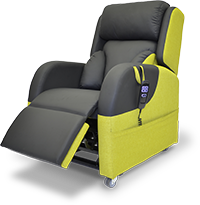As you know, a specialist chair can literally transform a patient’s quality of life. So making sure the chair you prescribe for them fits accurately and gives them the support and comfort they need, is absolutely essential.
If the specialist chair is too big it may enable them to rotate their body in a way that isn’t suitable or it may not provide proper pressure relief. If it fits too tightly, it could cause friction.
Follow our guide on how to accurately measure for specialist seating to get it right the first time – and give your client the highest level of comfort possible.
You will need:
- A sturdy tape measure with both inches and millimetres on it. If you use a fabric tape measure, please be careful that the measurements don’t skew and avoid bulky clothing. Keep the tape measure flat at all times.
- The specialist chair you are prescribing to keep the measurements accurate (we can supply the most compatible chair for you). If you can’t use the correct seat, a dining chair will suffice.
- Your client. Remember to explain what you are doing before you start measuring so that your patient is comfortable, co-operative and reassured.
Take these 5 measurements:
Seat width
Seat width should be measured from the inside of one armrest to the inside of the other. There should be about a ¾ inch (or 20mm) gap on either side of the client’s buttocks to make sure that the arms sit comfortably on the armrests.
Note: If the client’s knees are ‘windswept’ to one side, they may need additional accessories to support or correct this.
Seat depth
Seat depth determines how long the patient’s seat will be. It is the length from the back of the buttocks to behind the knee. If it is measured incorrectly, it could have a detrimental effect on posture or create pressure injuries.
To get the seat depth measure correct, place one hand on the back of the person being measured. With your other hand, place two fingers behind the patient’s knee. Measure from the palm of your hand to the edge of your closest finger, leaving about 1 inch of space to the patient’s knee.
Seat height
Seat height is an important measure to get right because up to 19% of a person’s weight is distributed through their feet whilst sitting. The seat height measure is the seat to floor (or footplate) length. It’s measured from behind the patient’s knee to the sole of their foot whilst they are seated.
Note: To ensure accuracy, we recommend measuring both legs, as some people’s legs can be different lengths.
Back height
This measurement will ensure your patient is comfortable and supported whenever possible. To measure correctly, ensure the person’s body is fully loaded in their chair. Measure from the top of the person’s head to the top of the cushion seat.
Note: You may need to open the back angle on your chair. As a general rule, the hip angle should match the angle of the back of the chair.
Armrest height
This measurement determines where the arms rest comfortably and can help a person get in and out of their chair. To take this measurement, hold the person’s arm at a 90-degree angle as if it was resting on an armrest. Measure from just below the arm to the top of the seat cushion. Your client’s arm should sit naturally with the should in a neutral position.For more information on how Premiere Healthcare can support you when choosing specialist seating, please get in touch.









